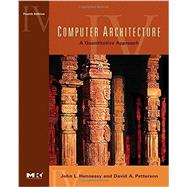
| Fundamentals of Computer Design | |
| Introduction | |
| The Changing Face of Computing and the Task of the Computer Designer | |
| Technology Trends | |
| Cost, Price, and their Trends | |
| Measuring and Reporting Performance | |
| Quantitative Principles of Computer Design | |
| Putting It All Together: Performance and Price-Performance | |
| Another View: Power Consumption and Efficiency as the Metric | |
| Fallacies and Pitfalls | |
| Concluding Remarks | |
| Historical Perspective and References Exercises | |
| Instruction Set Principles and Examples | |
| Introduction | |
| Classifying Instruction Set Architectures | |
| Memory Addressing | |
| Addressing Modes for Signal Processing | |
| Type and Size of Operands | |
| Operands for Media and Signal Processing | |
| Operations in the Instruction Set | |
| Operations for Media and Signal Processing | |
| Instructions for Control Flow | |
| Encoding an Instruction Set | |
| Crosscutting Issues: The Role of Compilers | |
| Putting It All Together: The MIPS Architecture | |
| Another View: The Trimedia TM32 CPU | |
| Fallacies and Pitfalls | |
| Concluding Remarks | |
| Historical Perspective and References Exercises | |
| Instruction-Level Parallelism and its Dynamic Exploitation | |
| Instruction-Level Parallelism: Concepts and Challenges | |
| Overcoming Data Hazards with Dynamic Scheduling | |
| Dynamic Scheduling: Examples and the Algorithm | |
| Reducing Branch Costs with Dynamic Hardware Prediction | |
| High Performance Instruction Delivery | |
| Taking Advantage of More ILP with Multiple Issue | |
| Hardware Based Speculation | |
| Studies of the Limitations of ILP | |
| Limitations on ILP for Realizable Processors | |
| Putting It All Together: The P6 Microarchitecture | |
| Another View: Thread Level Parallelism | |
| Crosscutting Issues: Using an ILP Datapath to Exploit TLP | |
| Fallacies and Pitfalls | |
| Concluding Remarks | |
| Historical Perspective and References Exercises | |
| Exploiting Instruction Level Parallelism with Software Approaches | |
| Basic Compiler Techniques for Exposing ILP | |
| Static Branch Prediction | |
| Static Multiple Issue: the VLIW Approach | |
| Advanced Compiler Support for Exposing and Exploiting ILP | |
| Hardware Support for Exposing More Parallelism at Compile-Time | |
| Crosscutting Issues | |
| Putting It All Together: The Intel IA-64 Architecture and Itanium Processor | |
| Another View: ILP in the Embedded and Mobile Markets | |
| Fallacies and Pitfalls | |
| Concluding Remarks | |
| Historical Perspective and References Exercises | |
| Memory-Hierarchy Design | |
| Introduction | |
| Review of the ABCs of Caches | |
| Cache Performance | |
| Reducing Cache Miss Penalty | |
| Reducing Miss Rate | |
| Reducing Cache Miss Penalty or Miss Rate via Parallelism | |
| Reducing Hit Time | |
| Main Memory and Organizations for Improving Performance | |
| Memory Technology | |
| Virtual Memory | |
| Protection and Examples of Virtual Memory | |
| Crosscutting Issues in the Design of Memory Hierarchies | |
| Putting It All Together: Alpha 21264 Memory Hierarchy | |
| Another View: The Emotion Engine of the Sony Playstation 2 | |
| Another View: The Sun Fire 6800 Server | |
| Fallacies and Pitfalls | |
| Concluding Remarks | |
| Historical Perspective and References Exercises | |
| Multiprocessors and Thread-Level Parallelism | |
| Introduction | |
| Characteristics of Application Domains | |
| Symmetric Shared-Memory Architectures | |
| Performance of Symmetric Shared-Memory Multiprocessors | |
| Distributed Shared-Memory Architectures | |
| Performance of Distributed Shared-Memory Multiprocessors | |
| Synchronization | |
| Models of Memory Consistency: An Introduction | |
| Multithreading: Exploiting Thread-Level Parallelism within a Processor | |
| Crosscutting Issues | |
| Putting It All Together: Sun''s Wildfire Prototype | |
| Another View: Multithreading in a Commercial Server | |
| Another View: Embedded Multiprocessors | |
| Fallacies and Pitfalls | |
| Concluding Remarks | |
| Historical Perspective and References Exercises Cha | |
| Table of Contents provided by Publisher. All Rights Reserved. |
The New copy of this book will include any supplemental materials advertised. Please check the title of the book to determine if it should include any access cards, study guides, lab manuals, CDs, etc.
The Used, Rental and eBook copies of this book are not guaranteed to include any supplemental materials. Typically, only the book itself is included. This is true even if the title states it includes any access cards, study guides, lab manuals, CDs, etc.